 W
WAntonio Hall, also known as Antonio House and previously Kilmead and Campion Hall, is a historic mansion in the Christchurch suburb of Riccarton. Although protected as a Category II heritage building by Heritage New Zealand, it has been left to fall into ruin. A large property with 279 rooms and once described as "one of the finest in Christchurch and vicinity", it was for three decades used as a Catholic seminary. Antonio Hall suffered a major fire in July 2019.
 W
WAntrim House of Wellington, New Zealand, was completed in 1905 for Robert Hannah (1845–1930) and his wife Hannah Hannah (1852–1928).
 W
WBushy Park Homestead is an Edwardian-era homestead registered as a Category I heritage building by Heritage New Zealand. It is located in Bushy Park, at 791 Rangitatau East Road, 8 kilometres (5.0 mi) from Kai Iwi, Whanganui, in the Manawatū-Whanganui region.
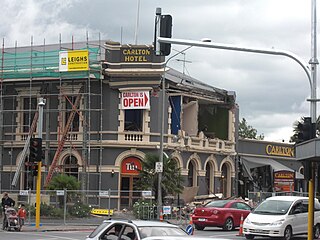 W
WThe Carlton Hotel in Christchurch was an historic pub on the corner of Papanui Road and Bealey Avenue. Built in 1906 for the New Zealand International Exhibition, it was registered by the New Zealand Historic Places Trust as a Category II heritage building. The building was damaged in the February 2011 Christchurch earthquake and demolished on 9 April 2011.
 W
WThe Carrigafoyle is a historic building in Wellington, New Zealand.
 W
WThe Cathedral of the Blessed Sacrament is located in the city centre of Christchurch, New Zealand. It is the mother church of the Roman Catholic Diocese of Christchurch and seat of the Bishop of Christchurch, currently Bishop Paul Martin SM.
 W
WChristChurch Cathedral, also called Christ Church Cathedral and (rarely) Cathedral Church of Christ, is a deconsecrated Anglican cathedral in the city of Christchurch, New Zealand. It was built between 1864 and 1904 in the centre of the city, surrounded by Cathedral Square. It became the cathedral seat of the Bishop of Christchurch, who is in the New Zealand tikanga of the Anglican Church in Aotearoa, New Zealand and Polynesia.
 W
WThe Civic Theatre is a theatrical venue in the southern New Zealand city of Invercargill.
 W
WThe Civic in Manchester Street, Christchurch Central City, was one of the former civic buildings of Christchurch City Council (CCC). Built in 1900, it was first used as an exhibition hall, a cinema and then a theatre. It burned down in 1917. The northern part of the building was purchased by CCC and opened as the civic office in 1924, and served this purpose until 1980. After that it had several uses, including a restaurant, bar and live music venue. The building was heavily damaged in the February 2011 Christchurch earthquake, and was demolished.
 W
WConsultancy House is a historic building in The Exchange, in downtown Dunedin, New Zealand. It has a New Zealand Historic Places Trust grade I classification.
 W
WDaresbury, earlier known as Daresbury Rookery is one of the finest grand houses in Christchurch, New Zealand. Designed in the English Domestic Revival style, it is one of the best designs of Samuel Hurst Seager.
 W
WThe Dominion Observatory is a historic observatory in the Botanic Gardens in Wellington, New Zealand. It was the second observatory in Wellington. It was built in 1907 and originally named the Hector Observatory after James Hector until 1925. It was built to replace the Colonial Observatory which was located in the Bolton Street Cemetery.
 W
WThe Dunedin Law Courts is a notable historic building in central Dunedin, in the South Island of New Zealand. They are located at the corner of Lower Stuart Street and Anzac Square, directly opposite the city's historic railway station. Since 1902, the building has been used as the city's law courts, and contains four court rooms, including the ornate High Court, as well as housing the offices and library of the Law Society.
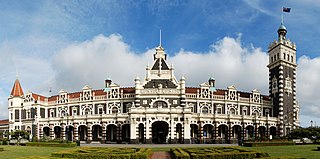 W
WDunedin railway station in Dunedin on New Zealand's South Island, designed by George Troup, is the city's fourth station. It earned its architect the nickname of "Gingerbread George".
 W
WEast Cape Lighthouse is a lighthouse sited on Otiki Hill above East Cape, the easternmost point on the North Island of New Zealand. It is owned and operated by Maritime New Zealand. The lighthouse was originally constructed on nearby East Island. However the island was difficult to access and proved to be susceptible to earthquakes and subsequent landslips. In 1920 a decision was made to relocate the light to the mainland and in April 1922, the light was extinguished and then relit at its current location in December of that year. Originally manned by three lighthouse keepers, the light's staffing was progressively reduced until it was fully automated in 1985. It is now controlled from the Maritime New Zealand headquarters in Wellington. While the area around the light is accessible by foot, the lighthouse itself is not open to the public.
 W
WErskine College is a collection of historic buildings and landscapes in Wellington, New Zealand.
 W
WThe former Government Buildings in Hokitika, also known as Seddon House, are on the West Coast of the South Island of New Zealand. The building is classified as a "Category I" historic place by Heritage New Zealand Pouhere Taonga, previously known as the New Zealand Historic Places Trust.
 W
WThe Hokitika Clock Tower, initially called the Westland War Memorial and then the Coronation and War Memorial, is a prominent landmark in Hokitika, New Zealand. The memorial was initiated, fundraised for, and carried out by a committee, to commemorate the region's contribution to the Second Boer War; not just the four local men who had died but all 130 who had gone to war in South Africa. An additional purpose was to provide Hokitika with a town clock.
 W
WHokitika Museum is a museum in Hokitika on the West Coast of the South Island in New Zealand, and is the West Coast's largest museum and archive. It is housed in the historic Hokitika Carnegie Library building. Exhibitions include information about the gold rush and the unique West Coast stone pounamu (greenstone) and its value to Māori. The museum also holds a significant photographic collection. Seismic strengthening requirements closed the museum in 2016, with an estimated opening date of late 2020 to mid 2021.
 W
WThe Hunter Building is the original building of the Victoria University of Wellington campus in Wellington, New Zealand.
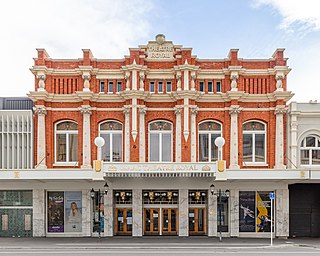 W
WThe Isaac Theatre Royal, is a heritage building in Christchurch, New Zealand, designed by brothers Sidney and Alfred Luttrell. Built in 1908 it is the only operational Edwardian style Theatre remaining in New Zealand.
 W
WKaikorai Presbyterian Church is a Presbyterian congregation of the PCANZ Presbyterian Church of Aotearoa New Zealand located in Kaikorai, a suburb of Dunedin, New Zealand.
 W
WThe Karori Crematorium and its adjacent chapel are located in Karori Cemetery in the Wellington suburb of Karori. The crematorium was the first such facility in New Zealand, and it opened in 1909. The Karori Crematorium and chapel are registered by the New Zealand Historic Places Trust as Category I heritage items, with registration number 1399.
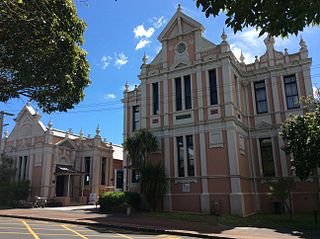 W
WLeys Institute Library Ponsonby is a branch of Auckland Libraries that serves the suburbs of Ponsonby, Saint Marys Bay, Herne Bay, and Freemans Bay. It is housed in The Leys Institute, a pair of historic buildings that incorporate a lecture hall, a meeting room and a gymnasium, as well as a public library.
 W
WThe Lyttelton Times Building, last known as Base Backpackers, in 56 Cathedral Square, Christchurch Central City, was the last headquarters of the Lyttelton Times before its demise in 1935 as the then-oldest newspaper in New Zealand. The building in Chicago School architectural style was registered with New Zealand Historic Places Trust as a Category I heritage item, with the registration number 7216. The building's last use was as a backpackers' hostel and a restaurant. It was demolished following the February 2011 Christchurch earthquake.
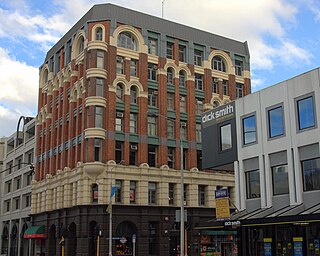 W
WManchester Courts, earlier known as the MLC Building, was a commercial high-rise building in the Christchurch Central City. Built in 1905–1906 for the New Zealand Express Company, it was at the time the tallest commercial building in Christchurch. A Category I heritage building, it suffered serious structural damage in the 2010 Canterbury earthquake and was condemned to be demolished. Demolition began on 19 October, and was completed in February 2011.
 W
WMcLean's Mansion is a homestead in Christchurch, New Zealand. The two hectares property is situated between Manchester and Colombo Streets. The mansion was initially known as 'Holly Lea', but later became known as McLean's Mansion after its initial owner. It was the largest wooden residence in New Zealand. The mansion, designed by Robert England, architect of Christchurch, is a fusion of styles of Jacobean architecture and Victorian features, akin to the Mentmore Towers (1852–54) of Sir Joseph Paxton in Buckinghamshire in England. It was built between April 1899 and September 1900. The house is registered as a Category I heritage building by Heritage New Zealand. After the 2011 Christchurch earthquake, the owners applied to demolish the earthquake-damaged buildings, but their request was denied by the heritage body and the courts. In December 2016, the building sold to a trust that will restore it for use as a gallery.
 W
WThe Old Bank Arcade is a historic building on Lambton Quay, Wellington, New Zealand.
 W
WOlveston Historic Home is a substantial house in an inner suburb of Dunedin, New Zealand.
 W
WDr Henry Pollen's House is a historic building in Wellington, New Zealand. The house was built in 1902 for Dr Henry Pollen as a residence and surgery. It was designed by William Turnbull. It was originally located at 12 Boulcott Street but was moved to the corner of Boulcott Street and Willis Street in 1988 to make room for the Majestic Centre. It is now home to a restaurant, The General Practitioner.
 W
WThe Press Building located in Cathedral Square in Christchurch was the home of The Press between 1909 and February 2011. The building in perpendicular Gothic is registered with the New Zealand Historic Places Trust as a Category I heritage item, with the registration number 302. The building suffered significant damage in the February 2011 Christchurch earthquake, with one staff member killed in the collapsed top floor. The building was demolished in July and August 2011.
 W
WThe Public Trust Office Building is an office building in central Wellington, New Zealand, completed in 1908. It is the only (surviving) building "made of a true New Zealand granite – from Tonga Bay in north-west Nelson." It is also believed to be New Zealand's first steel-framed office building.
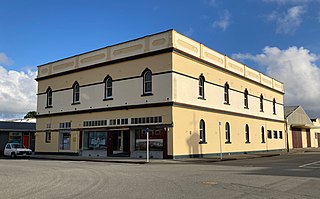 W
WThe Renton Hardware building, also known as the Okitiki building, is a commercial building in Hokitika, on the West Coast of New Zealand's South Island. Completed in 1908, the building was designed by architect Arthur Griffin, who was also responsible for the nearby Carnegie library. In 1989, the Renton building was granted historic place category 2 status by Heritage New Zealand.
 W
WThe Rotorua Museum Te Whare Taonga o Te Arawa is a local museum and art gallery in the Government Gardens near the centre of Rotorua, Bay of Plenty, North Island, New Zealand.
 W
WThe Royal Wanganui Opera House is New Zealand's last Victorian theatre. Located in St Hill Street in central Wanganui, the 110-year-old theatre seats 830 and is the venue for many local, national and international events.
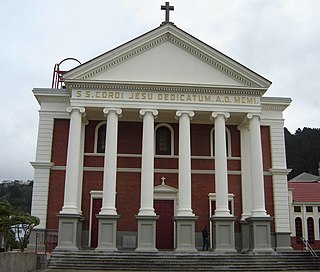 W
WThe Metropolitan Cathedral of the Sacred Heart and of Saint Mary His Mother, better known as Sacred Heart Cathedral, is a Roman Catholic cathedral on Hill Street, Wellington, New Zealand. It is the parish church of the Thorndon Catholic parish and the Cathedral of the Archbishop of Wellington. The New Zealand Parliament is a close neighbour of the Cathedral. However, the Thorndon Catholic parish predates that institution. The Cathedral is part of a Catholic precinct which includes St Mary's College; Sacred Heart Cathedral School; St Mary's Convent, the motherhouse of the Sisters of Mercy in Wellington; the Catholic Centre, in which Catholic administration is located; and Viard House, which is both the Cathedral parish presbytery and the residence of the Archbishop.
 W
WSt Gerard's Church and Monastery collectively form one of Wellington's most distinctive and iconic landmarks. Located on Mount Victoria in Wellington, both buildings are classified as "Category I" historic places by the New Zealand Historic Places Trust. They are built on the site of a sixteen-roomed house and property owned by James Edward Fitzgerald who some claim to be New Zealand's first Prime Minister.
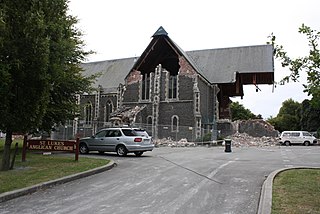 W
WSt Luke's Church in Christchurch was registered as a Category II historic place with the New Zealand Historic Places Trust. Built on one of the five sites set aside in the central city in the original survey of Christchurch for the Anglican church, it was demolished in July 2011 following damage sustained in the February 2011 Christchurch earthquake.
 W
WSt Matthew's, or St Matthew-in-the-City, is a historic Anglican church located in the Central Business District of Auckland, renowned for its neo-Gothic style since its completion in 1905.
 W
WSt Patrick's Basilica as it is known because of its style of architecture, was built in 1908–1909, with the tower added in 1912. It is located in Waimate, South Canterbury, New Zealand. It is an Italianate-Romanesque style with an arcaded portico and the tower is impressively louvred. The Basilica was built in brick and Oamaru stone to a design by Francis William Petre and has been described as his most original work. Three bells in the tower were cast in Belgium, with the largest bell weighing 3/4 of ton and the other two weighing 1/2 ton each. The tower at the top was built in 1912 and is 45ft high. Within is a fine Hobday pipe organ, a marble altar and a notable sanctuary window. The Basilica is listed by Heritage New Zealand as a Historic Place, Category 1.
 W
WThe Cathedral of St Patrick and St Joseph is a Catholic church in Auckland CBD, situated on the corner of Federal Street and Wyndham St. It is the mother church of the Roman Catholic Diocese of Auckland and the cathedral of the Bishop of Auckland.
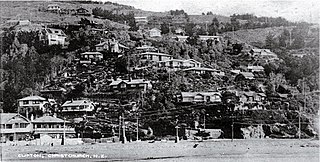 W
WThe Spur is a collection of interconnected Arts and Crafts bungalows in Clifton, Christchurch.
 W
WThe Stewart Dawson's building is a historic building on the corner of Lambton Quay and Willis Street in Wellington, New Zealand. Built in 1901 for the London jeweller David Stewart Dawson, it is located on a prominent corner in two of Wellington's major streets, a site particularly important to history of Wellington.
 W
WTaumarunui railway station in Taumarunui, New Zealand was the main railway station in Taumarunui. Formerly it was an important intermediate stop with a refreshment room on the North Island Main Trunk line; the subject of a ballad by Peter Cape.
 W
WThe Tuhawaiki Point Lighthouse or Jack's Point Lighthouse stands near to Timaru at the east coast of the South Island of New Zealand.
 W
WWaitomo Caves Hotel is a historic hotel built in 1908 that is located in Waitomo District, King Country above Waitomo Caves in New Zealand. The building is famous for its unique style of New Zealand Victorian.
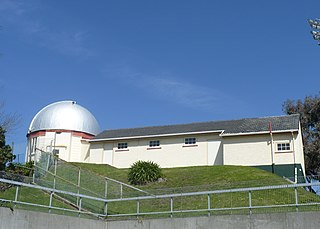 W
WThe Ward Observatory is an astronomical observatory in Whanganui, New Zealand. Built in 1901 and administered by the Wanganui Astronomical Society, it is named after Joseph Ward (1862–1927), the society's first president and longtime director of the observatory. It houses a 9½ inch (24 cm) telescope, the largest unmodified refractor telescope in use in New Zealand.
 W
WThe Wellesley Club building is a historic building in Wellington, New Zealand.
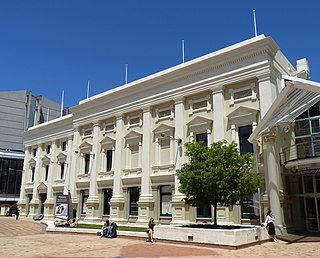 W
WThe Wellington Town Hall is a concert hall and part of the municipal complex in Wellington, New Zealand, which opened in December 1904. It has been closed to the public since the 2013 Seddon earthquake, and it is currently undergoing extensive strengthening work.
 W
WWestern Hutt railway station, formerly Lower Hutt, is an intermediate station on the single-track Melling Line in Lower Hutt, New Zealand, It is served by Metlink electric multiple unit trains operated by Tranz Metro.
 W
WThe Westland District Library is the public library in Hokitika, on the West Coast of New Zealand. Beginning as the Hokitika Literary Society in 1866, it occupied a Carnegie library building from 1908 as the Hokitika Free Public Library, moving out in 1975.
 W
WWharetiki, for some time known as Glenfell House, was an Edwardian timber dwelling in Colombo Street, Christchurch in New Zealand. Built in 1904 for businessman and philanthropist Matthew Barnett, it was damaged in the February 2011 Christchurch earthquake. After the Canterbury Earthquake Recovery Authority ordered the demolition of the Category II heritage building registered by Heritage New Zealand, it was the first court challenge of CERA's post-earthquake powers. In July 2011, the High Court decided in the authority's favour and the building was demolished the following day.